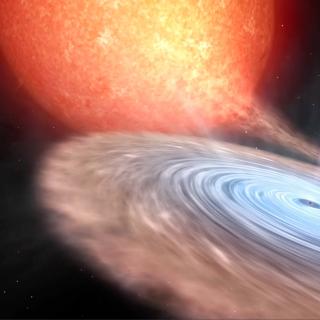Bibcode
Giustini, Margherita; Miniutti, Giovanni; Arcodia, Riccardo; Goodwin, Adelle; Alexander, Kate D.; Chakraborty, Joheen; Buchner, Johannes; Kosec, Peter; Saxton, Richard; Bonetti, Matteo; Franchini, Alessia; Ryu, Taeho; Shu, Xinwen; Kara, Erin; Ponti, Gabriele; Quintin, Erwan; Vincentelli, Federico; Webb, Natalie; Kajava, Jari; von Fellenberg, Sebastiano D.
Bibliographical reference
Astronomy and Astrophysics
Advertised on:
12
2024
Journal
Citations
25
Refereed citations
21
Description
Quasi-periodic eruptions (QPEs) are an extreme X-ray variability phenomenon associated with low-mass (MBH < 107 M⊙) supermassive black holes (SMBHs). First discovered in the nucleus of the galaxy GSN 069, they have been so far securely detected in five other galaxies, including RX J1301.9+2747. When detected, the out-of-QPE emission (quiescence) is consistent with the high-energy tail of thermal emission from an accretion disk. In this article we present the X-ray properties of RX J1301.9+2747, both in quiescence and during QPEs, and complement this information with radio observations. We analyze X-ray data taken during five XMM-Newton observations between 2000 and 2022. The last three observations were taken in coordination with radio observations with the Karl G. Jansky Very Large Array. We also made use of EXOSAT, ROSAT, and Chandra archival observations taken between 1983 and 2009. XMM-Newton detected 34 QPEs of which eight have significantly lower amplitudes than the others. No correlated radio/X-ray variability was observed during QPEs. In terms of timing properties, the QPEs in RX J1301.9+2747 do not exhibit the striking regularity observed in the discovery source GSN 069. In fact there is no clear repetition pattern between QPEs: the average time separation between their peaks is about four hours, but it can be as short as one, and as long as six hours. The QPE spectral properties of RX J1301.9+2747 as a function of energy are, however, very similar to those of GSN 069 and of other QPE sources. During their evolution, X-ray QPEs follow a hysteresis pattern in the temperature-luminosity plane, with a hotter rise than decay. The quiescent emission of RX J1301.9+2747 is more complex than that of GSN 069, as it requires a soft X-ray excess-like component in addition to the thermal emission from the accretion disk. Its long-term X-ray quiescent flux variations are of a low amplitude and not strictly monotonic, with a general decay over the course of ∼22 years. We discuss our observational results in terms of some of the ideas and models that have been proposed so far for the physical origin of QPEs.
Related projects

Black holes, neutron stars, white dwarfs and their local environment
Accreting black-holes and neutron stars in X-ray binaries provide an ideal laboratory for exploring the physics of compact objects, yielding not only confirmation of the existence of stellar mass black holes via dynamical mass measurements, but also the best opportunity for probing high-gravity environments and the physics of accretion; the most
Montserrat
Armas Padilla